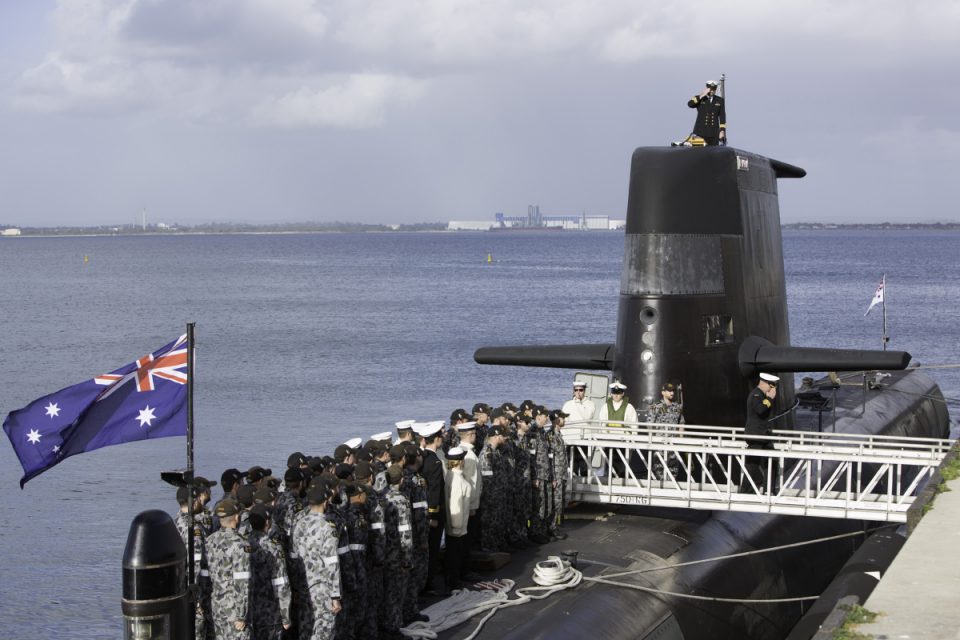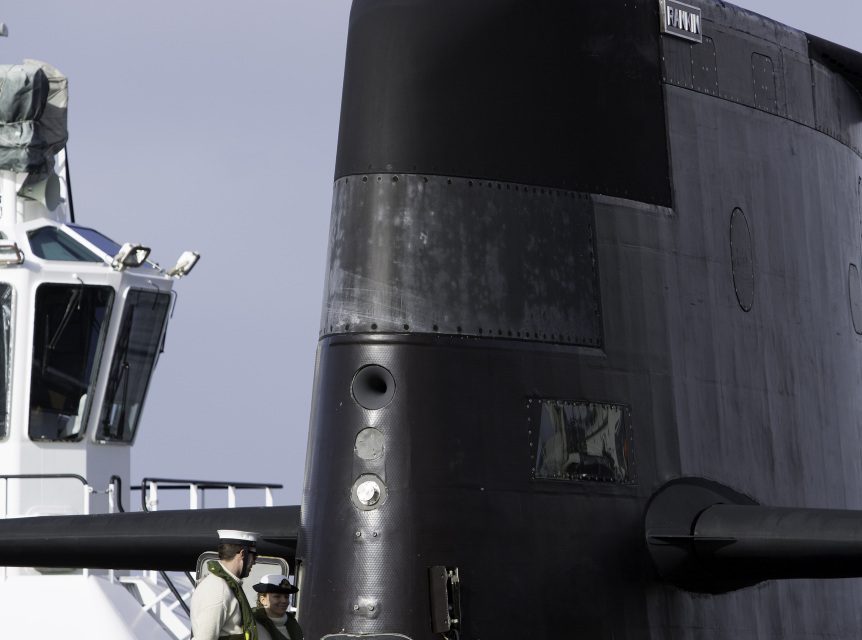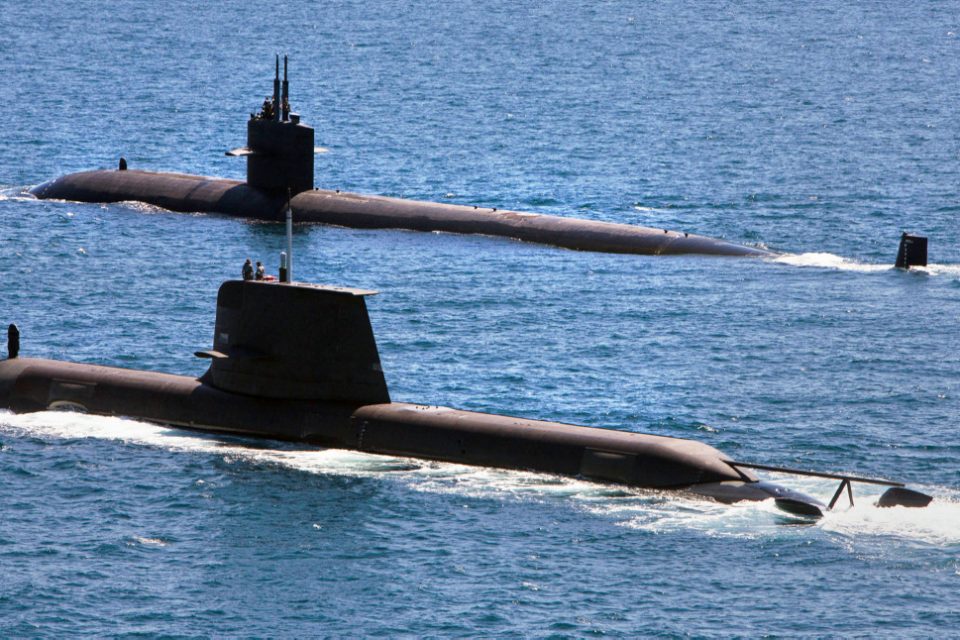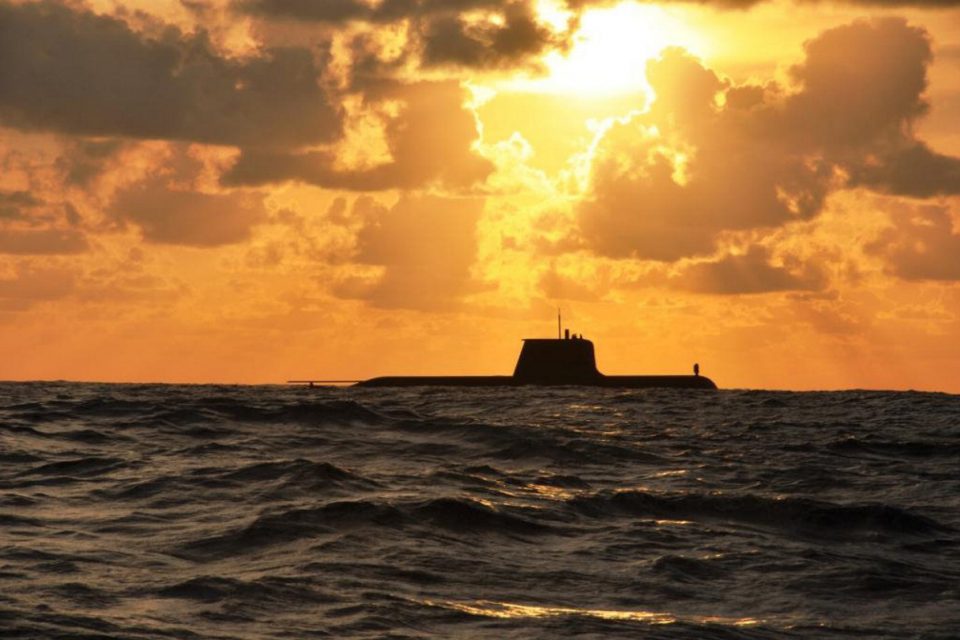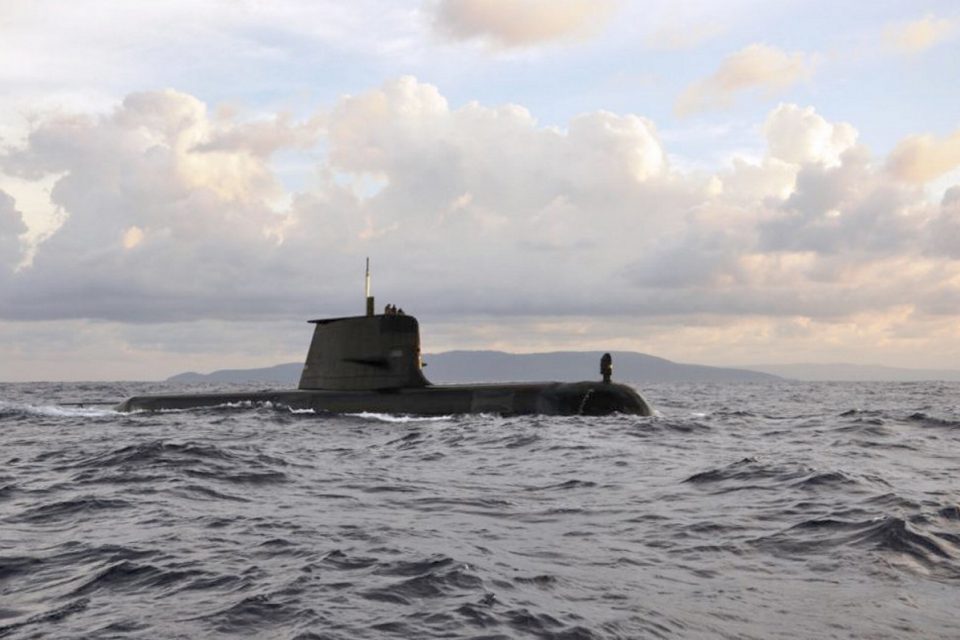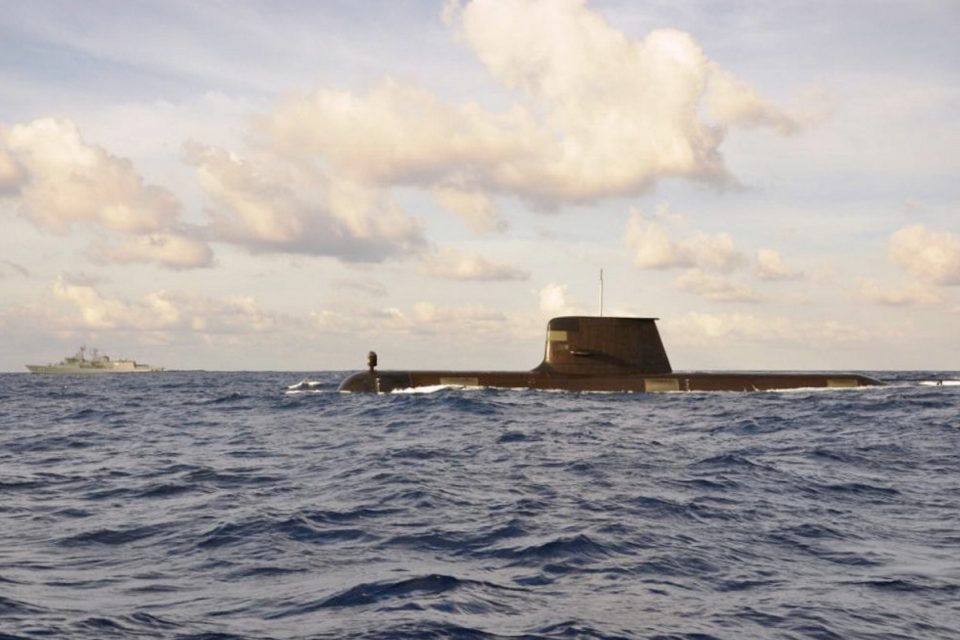2017-05-21 As a key part of shaping its enhanced defense capabilities, the Australian government has launched a comprehensive and long term shipbuilding program.
The plan was officially launched on May 16 at a ceremony held in Adelaide.
According to text and a video released by the Australian Department of Defence:
Prime Minister of Australia, the Honourable Malcolm Turnbull, Minister for Defence, Senator the Honourable Marise Payne and Minister for Defence Industry, the Honourable Christopher Pyne MP, announced the release of the Naval Shipbuilding Plan at the Osborne Naval Shipyard in Adelaide on 16 May 2017.
The Naval Shipbuilding Plan provides the strategic direction for a significant national endeavour to secure Australia’s naval shipbuilding and sustainment industry.
It outlines the Government’s vision, significant investment and expectations of long-term partnerships and collaboration with key stakeholders to achieve this nation-building project.
5/16/17
Australian Department of Defence
During a visit to Australia last month, there was a chance to discuss with the Australian Chief of Navy, the way ahead in light of the commitment to a significant build of a new fleet.
2017-05-02 By Robbin Laird
During my most recent trip to Australia, the focus was upon how to shape an integrated ADF moving forward.
During my interviews surrounding the Williams Foundation seminar on that theme, I have had the chance to talk to key decision makers in shaping a way ahead.
Last August, I had a chance to talk with the Chief of the Australian Navy, Vice Admiral Tim Barrett.
A key speaker at the Williams Foundation seminar on air-land integration was the Chief of the Australian Navy, Vice Admiral Tim Barrett.
Barrett’s speech focused on the opportunities and challenges of the largest recapitalisation of the Australian Navy since World War II.
New submarines, destroyers and amphibious ships and associated fleet assets are being built in Australia to shape a new maritime capability for Australia.
But this force is being built in the time of significant innovation in the Pacific whereby new force concepts are being shaped, such as kill webs, distributed lethality, and fifth generation airpower.
Barrett made it very clear that what was crucial for the Navy was to design from the ground up any new ships to be core participants in the force transformation process underway.
We picked up where we left off from our August meeting.
Question: How do fight with the fleet you have and prepare at the same time for tomorrow’s fleet, especially when you have several new programs in the pipeline?
Vice Admiral Tim Barrett: You have to fight with the fleet you have now.
That is not an option; it is a necessity.
My focus to do that better and to lay the groundwork for the future fleet is to focus upon availability of assets.
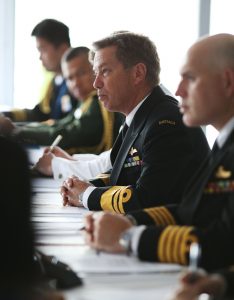 Chief of Navy, Vice Admiral Tim Barrett, AO, CSC, RAN holds the floor, during the Indian Ocean Naval Symposium (IONS) Conclave of Chiefs. Australia currently holds the Chairmanship of IONS. The regional forum was held during Sea Power 2015. *
Chief of Navy, Vice Admiral Tim Barrett, AO, CSC, RAN holds the floor, during the Indian Ocean Naval Symposium (IONS) Conclave of Chiefs. Australia currently holds the Chairmanship of IONS. The regional forum was held during Sea Power 2015. *
How to we get our availability rates higher?
How do we get ships to sea more effectively and more often?
They are not going to make much difference sitting in drydocks.
One can provide for enhanced deterrence through enhanced availability.
Question: You certainly don’t win with Power Point slides, do you?
Vice Admiral Tim Barrett: You certainly don’t nor with a connected force in those slides, represented by lightening bolts but not realized in practice.
For example, we have a small submarine fleet of six submarines; they are not going deter anybody if they are not available and capable of going to see.
As we discussed last time, we have put a major effort in getting much greater availability from our Collins class submarines, and the ways we have done so will shape our approach, our expectations and our template for the operation of the new class of submarines.
We have seen a dramatic improvement in our Collins Class boats.
Question: In other words, by learning how to ramp up availability with today’s fleet you are preparing the template for future operations?
Vice Admiral Tim Barrett: That is clearly our approach going forward.
We should be building our sense of availability in the design right now, so that when the future frigates arrive in place, we have maximized availability, and through that deterrence given their contribution to a distributed lethal force capability.
And this clearly is a key challenge for the workforce to shape enhanced availability.
We are reworking our work force to do so today, but must prepare for the transition in the workforce to do so in the future, recognizing that tomorrow’s platforms will be different, and different skill sets required ensuring enhanced availability.
Government has committed to a future navy in terms of key new platforms.
Naval Shipbuilding Plan from SldInfo.com on Vimeo.
I have that as a target goal so can work from here to there rather than simply fighting for the need to have a future fleet.
This certainty is crucial in allowing me to work the transition.
As we shape task force concepts for the current fleet, we are working connectors to make the fleet more effective in our task force approach.
As we work those connectors we are also anticipating how to build those into the design of the new fleet, rather than having to work the problem after we have acquired the platforms.
Question: And this is not simply about Navy, you focus is broader?
Vice Admiral Tim Barrett: It is; it is about working with industry; it is about working with the ADF; it is about working with government; in essence it is about the commitment of the nation.
We are a small force; smaller than the New South Wales Police Force.
We can not do this without a national commitment.
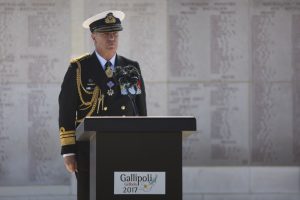 Chief of Navy, Vice Admiral Tim Barrett, AO, CSC, RAN, delivers the Ode of Remembrance at the Lone Pine commemorative service in Gallipoli.
Chief of Navy, Vice Admiral Tim Barrett, AO, CSC, RAN, delivers the Ode of Remembrance at the Lone Pine commemorative service in Gallipoli.
Question: One aspect of change clearly is building 21st century defense structure.
I have just returned from the UK and witnessed their significant efforts at Lossiemouth, Waddington, Marham and at Lakenheath to have a new infrastructure built.
And certainly have seen that at RAAF Williamtown with the F-35 and at RAAF Edinburgh with the P-8/Triton.
How important in your view is building a new infrastructure to support a 21st century combat force?
Vice Admiral Tim Barrett: Crucial.
And that is in part what I am referring to as an industrial and national set of commitments to shaping a 21st century combat fleet.
We spoke last time about the Ship Zero concept.
This is how we are focusing upon shaping a 21st century support structure for the combat fleet.
I want the Systems Program Office, the Group that manages the ship, as well as the contracted services to work together on site.
I want the trainers there, as well, so that when we’re maintaining one part of the system at sea, it’s the same people in the same building maintaining those things that will allow us to make future decisions about obsolescence or training requirements, or to just manage today’s fleet.
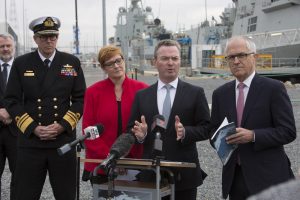 Minister for Defence Industry, the Honourable Christopher Pyne MP (centre right) at the announcement of the Naval Shipbuilding Plan in the presence of Acting Chief of the Defence Force, Vice Admiral Ray Griggs, AO, CSC, RAN (left), Minister for Defence, Senator the Honourable Marise Payne, and the Prime Minister of Australia, the Honourable Malcolm Turnbull.
Minister for Defence Industry, the Honourable Christopher Pyne MP (centre right) at the announcement of the Naval Shipbuilding Plan in the presence of Acting Chief of the Defence Force, Vice Admiral Ray Griggs, AO, CSC, RAN (left), Minister for Defence, Senator the Honourable Marise Payne, and the Prime Minister of Australia, the Honourable Malcolm Turnbull.
I want these people sitting next to each other and learning together.
It’s a mindset.
It puts as much more effort into infrastructure design as it does into combat readiness, which is about numbers today.
You want to shape infrastructure that is all about availability of assets you need for mission success, and not just readiness in a numerical sense.
Getting the right infrastructure to generate fleet innovation on a sustained basis is what is crucial for mission success.
And when I speak of a continuous build process this is what I mean.
We will build new frigates in a new yard but it is not a fire and forget missile.
We need a sustained enterprise that will innovate through the life of those frigates operating in an integrated ADF force.
That is what I am looking for us to shape going forward.
Question: An example of your approach to the future is clearly the new submarine.
A French design house and an American combat systems company will be working together really for the first time.
And they are building a submarine which has never been built before.
This provides an opportunity for you to shape a new support structure along the lines you have described going forward.
How do you see this process?
Vice Admiral Tim Barrett: It is something new and allows us to shape the outcome we want in terms of an upgradeable sustainable submarine with high availability rates built in. We intend to see this built that way from the ground up.
It is not simply about acquiring a platform.
We will not be a recipient of someone else’s design and thought.
This will be something that we do, and we will work with those that have a capacity to deliver what we say we need.
I think the way you characterize the process makes sense.
The experiences we’ve had through Collins have taught us a lot.
With 12 of these future submarines in a theater anti-submarine role we think we can make an effective contribution to our defense and to working with core allies in the region, notably the US Navy.
Editor’s Note: Vice Admiral Barrett has published a new book this year entitled The Navy and the Nation and Ed Timperlake recently commented on this book as follows:
The Aussies are not just buying new equipment; they are rethinking how to integrated that force and make a more effective and lethal combat capability.
A recent publication by the Australian Chief of Navy illustrates the point.
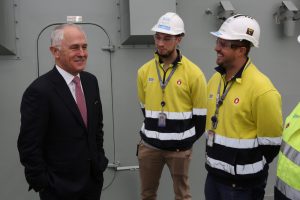 Prime Minister of Australia, the Honourable Malcolm Turnbull (left) speaks with Air Warfare Destroyer shipbuilders during a tour of NUSHIP Hobart.
Prime Minister of Australia, the Honourable Malcolm Turnbull (left) speaks with Air Warfare Destroyer shipbuilders during a tour of NUSHIP Hobart.
Australia’s Vice Admiral Tim Barrett has written a brilliant book about maritime power.
It is what is known as a “good read” because it is written with great insights presented in easily understandable prose.
He shows the reader why “The Navy and the Nation” is a sacred bond.
This passage is one of the most powerful ever written about the role of a Navy and the connection with their citizens:
“Most People think the Navy is something else.
“They know it exists, the may even have a rough idea of what it is for, but they don’t think it’s got much to do with them.
“They’re wrong.
“The Navy is a national enterprise in which everyone is involved and which everyone is involved and which delivers peace and security to everyone in the country.
“This enterprise is a two-way street, and must be a two-way street.
“Going one way, the Navy offers peace and security. Going the other, the people offer support and contribution. Only when the street is a properly mutual two-way exchange between the Navy and the citizens can this bargain, this contract, deliver what it needs to.”
The slideshow above highlights the Collins class submarines and the photos are credited to the Australian Department of Defence.
In a piece published by Andrew Greener of ABC news with regard to the challenge of generating and sustaining the workforce with regard to the program, a number of key points were underscored.
The Naval Shipbuilding Plan outlines over $1 billion in infrastructure upgrades at the Osborne shipbuilding facilities and Western Australia’s Henderson shipyards, while confirming construction is scheduled to begin on Australia’s Future Frigates by 2020.
According to the plan the existing infrastructure at Osborne is “sufficient” to continue block assembly of Australia’s three air warfare destroyers, but “inadequate” for “high productivity construction” of major surface combatants such as the future frigate.
Design for the Osborne South facilities will continue to be refined by Defence “in coming months”, with construction of new surface ship infrastructure to commence in the “second half of 2017”.
Completion of the infrastructure development is expected to be completed by the “second half of 2019”, but the report warned “this is the most time-critical component of the Government’s planned infrastructure works to enable the future frigate construction program to commence in 2020”.
“This is the largest single Commonwealth investment in any single state … it is going to create another 5,000 jobs in shipbuilding directly again, almost all of which will be in South Australia, and another 10,000 in sustainment,” Mr Turnbull told ABC Radio Adelaide this morning.
“This is a massive commitment to South Australia and the proposition that the Federal Government is neglecting South Australia is frankly nonsense and it defies the reality of this incredibly substantial nation-building commitment.
“As the naval shipbuilding plan says with our shipbuilding in the past we have had a boom and bust cycle … it’s coming to an end.
“And it is coming to an end because of my Government , my leadership, my commitment.”
The document predicted by 2026 more than 5,200 workers would be needed in South Australia, but acknowledged foreigners would be “essential” to “fill middle management and supervisory roles”.
“It is expected that over time the number of skilled workers from international shipyards will decline as the Australian workforce becomes familiar with construction requirements and develops more specialised skills,” the document stated.
“This will be an important area of discussion with selected shipbuilders as projects develop.”
The document also flagged a future taxpayer-funded advertising campaign to attract workers to Adelaide.
“The Government will explore the potential for skilled workers to relocate from interstate to South Australia,” the shipbuilding plan said.
“A public communications strategy will be important to raise awareness of the long-term and sustainable careers which will become available in naval shipbuilding as a result of the Government’s investments.”
Defence Teaming Centre chief executive Margot Forster said the vast majority of the construction workforce would be sourced locally.
But she said the inconsistent nature of Defence projects has led to a shortage of workers for supervisory and middle management roles.
“Australia … has not had a continuous shipbuilding program,” Ms Forster said.
“So what we have suffered from is coming into these programs, learning the skills, delivering quality products and then having to dismantle the workforce because there isn’t a follow-on project.”


